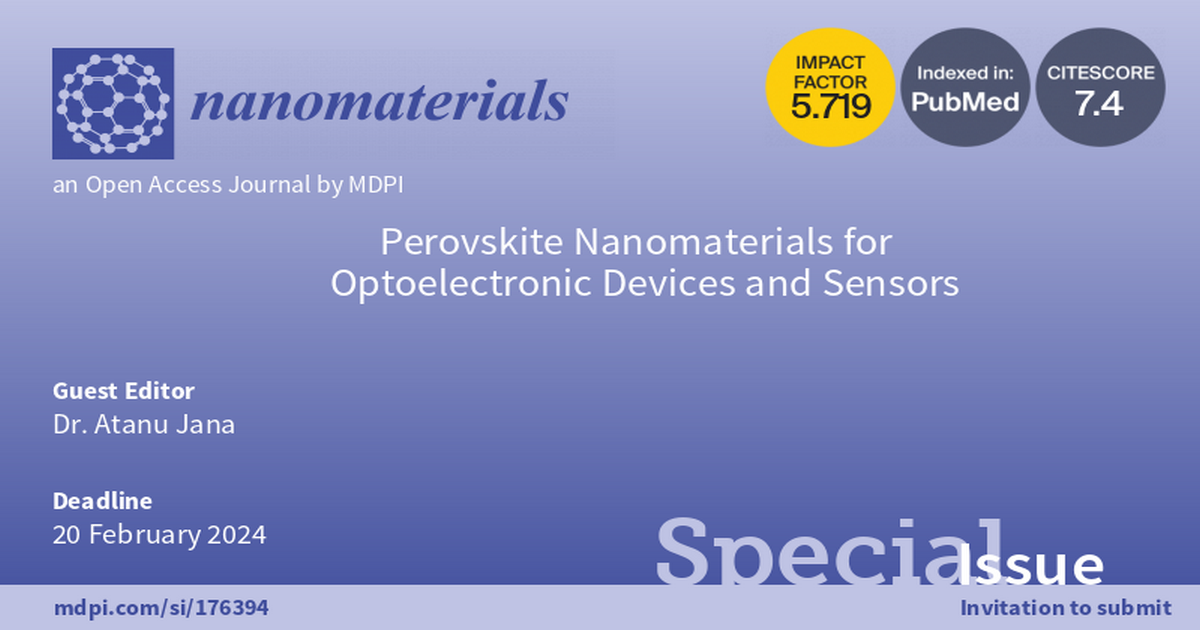Perovskite Nanomaterials for Optoelectronic Devices and Sensors
A special issue of Nanomaterials (ISSN 2079-4991). This special issue belongs to the section "Nanoelectronics, Nanosensors and Devices".
Deadline for manuscript submissions: closed (20 February 2024) | Viewed by 1620

Special Issue Editor
Interests: fluorescent nanomaterials; light-emitting diodes; X-ray scintillator and detector; X-ray imaging; thermally activated delayed fluorescence; circularly polarized luminescence; energy conversion and storage
Special Issues, Collections and Topics in MDPI journals
Special Issue Information
Dear Colleagues,
Perovskite nanomaterials have emerged as highly promising candidates for optoelectronic devices and sensors due to their exceptional properties. These materials exhibit remarkable optoelectronic performance, enabling their application in various technologies. In the realm of optoelectronic devices, perovskite nanomaterials have demonstrated outstanding performance in solar cells, light-emitting diodes (LEDs), and lasers. They possess high absorption coefficients, efficient charge carrier transport, and tunable emission wavelengths, allowing for the development of efficient solar cells, vibrant LEDs, sensitive photodetectors, and coherent lasers. Moreover, perovskite nanomaterials have been utilized in sensor applications such as photodetectors, gas sensors, biosensors, and strain/pressure sensors. Their abilities to detect light across a broad range of wavelengths, interact with specific gases or biomolecules, and exhibit piezoresistive or piezoelectric properties make them versatile for sensing various analytes and conditions. Continued research and development in this field promise to improve the stability, scalability, and reliability of perovskite nanomaterials, thereby exposing their full potential in advancing optoelectronic devices and sensors.
This Special Issue welcomes high-quality reviews and experimental, theoretical, and machine learning work on optoelectronic devices and sensors for perovskite nanomaterials. Potential topics include, but are not limited to, the following:
- The synthesis and optical properties of perovskite and related materials;
- Perovskite solar cells, LEDs, and lasers;
- Perovskite sensors, biosensors, and photodetectors.
Dr. Atanu Jana
Guest Editor
Manuscript Submission Information
Manuscripts should be submitted online at www.mdpi.com by registering and logging in to this website. Once you are registered, click here to go to the submission form. Manuscripts can be submitted until the deadline. All submissions that pass pre-check are peer-reviewed. Accepted papers will be published continuously in the journal (as soon as accepted) and will be listed together on the special issue website. Research articles, review articles as well as short communications are invited. For planned papers, a title and short abstract (about 100 words) can be sent to the Editorial Office for announcement on this website.
Submitted manuscripts should not have been published previously, nor be under consideration for publication elsewhere (except conference proceedings papers). All manuscripts are thoroughly refereed through a single-blind peer-review process. A guide for authors and other relevant information for submission of manuscripts is available on the Instructions for Authors page. Nanomaterials is an international peer-reviewed open access semimonthly journal published by MDPI.
Please visit the Instructions for Authors page before submitting a manuscript. The Article Processing Charge (APC) for publication in this open access journal is 2900 CHF (Swiss Francs). Submitted papers should be well formatted and use good English. Authors may use MDPI's English editing service prior to publication or during author revisions.
Keywords
- perovskite nanomaterial synthesis
- optical study
- solar cells
- light-emitting diodes
- photodetectors
- lasers
- photodetectors
- gas sensors
- biosensors
- strain/pressure sensors






